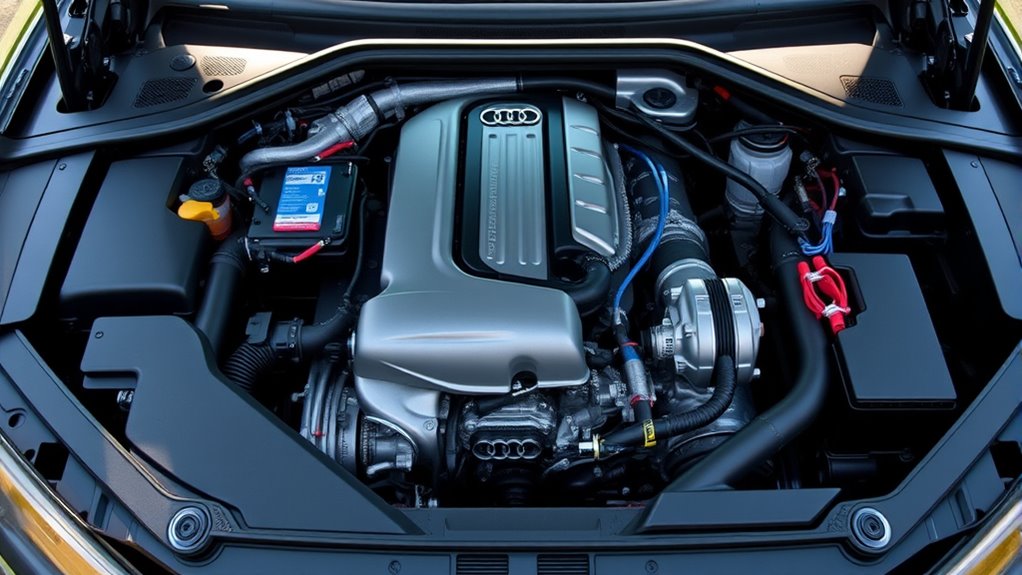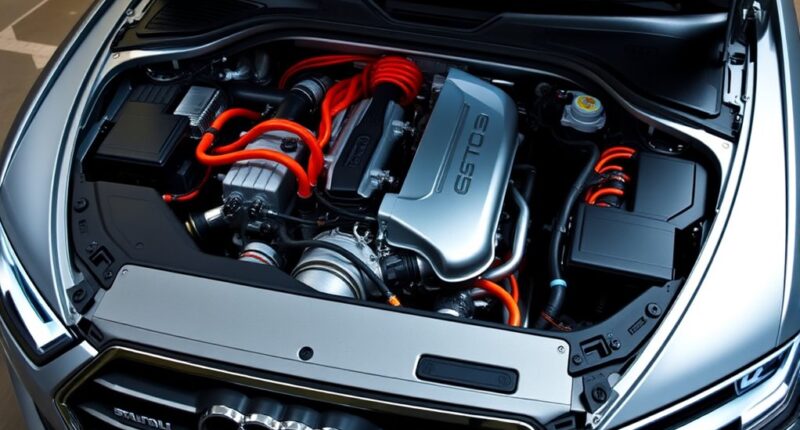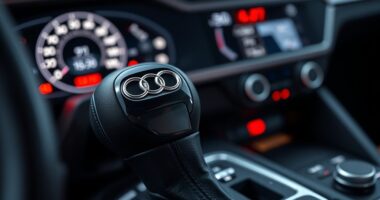Before tuning your Audi, it’s important to understand its mild-hybrid system. This tech uses an electric motor to support the combustion engine, improving fuel efficiency and reducing emissions. It recovers energy through regenerative braking and supports smooth acceleration and deceleration. Since it’s integrated seamlessly, tuning should consider how the system works to avoid issues. Continuing your exploration will help you see how to optimize performance while maintaining the system’s benefits.
Key Takeaways
- Audi’s mild-hybrid system uses an electric motor to assist the combustion engine, improving fuel efficiency and reducing emissions.
- It recovers energy during braking via regenerative braking, storing it in a high-voltage battery for later use.
- The system supports smoother acceleration and deceleration without replacing or significantly modifying the engine.
- It does not require external charging, relying solely on regenerative energy and engine operation.
- Tuning should consider the system’s energy recovery and support features to avoid compromising its efficiency and reliability.

Audi’s mild-hybrid system is designed to enhance your driving experience by improving fuel efficiency and reducing emissions without sacrificing performance. When you get behind the wheel of an Audi equipped with this technology, you’ll notice how seamlessly it integrates with your driving style. The system relies on an electric motor that works alongside the traditional combustion engine, providing subtle support during acceleration and deceleration. This electric motor isn’t meant to replace your engine but to assist it, making your overall driving more efficient.
One of the key features of Audi’s mild-hybrid system is regenerative braking. As you lift off the accelerator or brake, the system captures kinetic energy that would otherwise be lost as heat. This energy is then converted into electrical energy and stored in a small, high-voltage battery. When you need a boost—such as during acceleration—the stored energy is deployed to assist the engine, reducing fuel consumption and emissions. You’ll find that regenerative braking not only contributes to better efficiency but also promotes a smoother driving experience, with less abrupt stops and starts.
The electric motor in Audi’s mild-hybrid setup works quietly and efficiently, providing assistance during high-demand situations without overwhelming your driving experience. It kicks in during acceleration to give you a little extra power, helping the engine operate more efficiently. When you decelerate or brake, regenerative braking takes over, converting your energy into usable electrical power. This cycle of energy recovery and assistance keeps your vehicle running more sustainably without requiring extensive modifications to your typical driving habits.
You won’t need to plug in your car to recharge the battery, as the system relies on regenerative braking and the engine’s normal operation to keep the battery charged. This makes it a convenient and practical upgrade for drivers looking to improve fuel economy without the hassle of electric vehicle charging stations. Additionally, the system’s integration can benefit from understanding water-based systems, which influence vehicle cooling and efficiency. You’ll notice that your car often switches between using the engine and electric support seamlessly, almost invisibly to you. The system is designed to optimize efficiency without compromising the power and performance you expect from an Audi.
In essence, Audi’s mild-hybrid system is a smart, efficient way to make your driving more eco-friendly. It maximizes energy recovery through regenerative braking and provides electric assistance with the electric motor, all while maintaining the dynamic driving experience that’s characteristic of Audi. By understanding how this system works, you can better appreciate the balance of power and efficiency it offers, and how it subtly enhances your everyday journeys.
Frequently Asked Questions
How Does Audi’S Mild-Hybrid System Differ From Full Hybrid Systems?
Audi’s mild-hybrid system differs from full hybrid systems because it has a smaller battery capacity, mainly assisting the engine rather than powering the car alone. It uses regenerative braking to recover energy and support the engine during acceleration, improving efficiency. Unlike full hybrids, it doesn’t allow you to run solely on electric power. Instead, it enhances performance and fuel economy by providing brief electric support during driving, without the capability for extended electric driving.
Can I Upgrade My Audi’S Mild-Hybrid System for Better Performance?
Imagine your Audi’s mild-hybrid system is a vintage radio—there’s potential, but it could use some tuning. You might consider performance upgrades or battery enhancements to boost efficiency and response. However, unlike full hybrids, mild-hybrids have limitations, so upgrading isn’t straightforward. Consult a professional to explore compatible modifications that can improve your system’s performance without compromising its reliability. Just like a fine-tuned vintage radio, your car can sound even better.
What Maintenance Is Required for Audi’S Mild-Hybrid Technology?
To maintain your Audi’s mild-hybrid system, you should regularly check the battery longevity and guarantee it’s functioning properly. Keep an eye on the battery’s health and replace it if needed to prevent performance issues. Additionally, stay up-to-date with software updates from Audi, as they often include important improvements and fixes for the hybrid system. Proper maintenance helps maximize efficiency and prolongs the life of your vehicle’s hybrid components.
How Does the Mild-Hybrid System Impact Fuel Economy in Real-World Driving?
You might think a mild-hybrid won’t save much fuel, but it actually makes a difference in real-world driving. When you use regenerative braking, the system captures energy to recharge the battery, and the engine shuts off at idle to save fuel. These features work seamlessly, helping you improve fuel economy without sacrificing performance. So, in daily driving, your Audi becomes more efficient, saving you money and reducing emissions.
Are There Specific Driving Habits That Optimize the Mild-Hybrid System’S Benefits?
To optimize your mild-hybrid system’s benefits, adopt eco-friendly driving habits like gentle acceleration and braking, which enhance battery management. Avoid aggressive driving, as it reduces regenerative braking efficiency and fuel savings. Consistently maintaining steady speeds helps the system recharge the battery more effectively. By practicing these habits, you’ll maximize fuel economy and enjoy smoother driving, all while supporting a more eco-friendly approach.
Conclusion
Now that you understand Audi’s mild-hybrid system, you’re not just upgrading your car—you’re transforming your driving experience into something almost futuristic. This isn’t just a tech feature; it’s the secret weapon that could save you fuel, money, and even the planet. So, when you tune your Audi, remember, you’re not just making it better—you’re releasing a powerhouse of innovation that might just change how you see driving forever.









